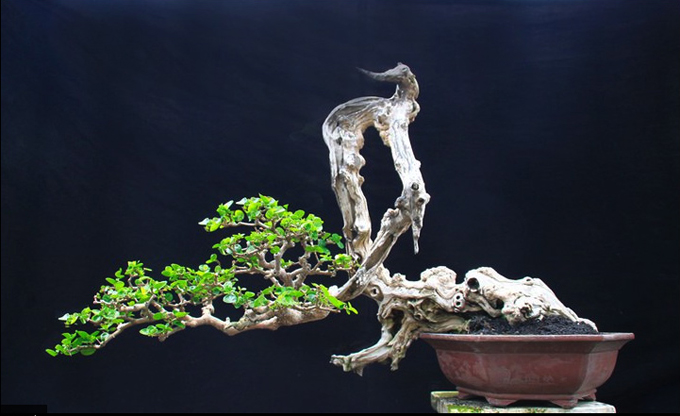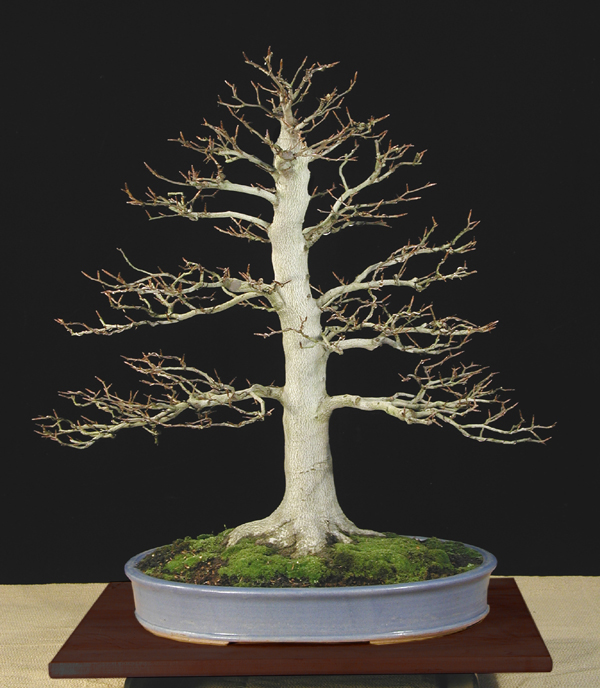 This venerable, naturally dwarfed Ponderosa belongs to American/British bonsai artist and teacher, Colin Lewis. Colin lives on the coast of Maine. Ponderosa pines grow in the inland mountains of the western U.S.; two distinctively different environments.
This venerable, naturally dwarfed Ponderosa belongs to American/British bonsai artist and teacher, Colin Lewis. Colin lives on the coast of Maine. Ponderosa pines grow in the inland mountains of the western U.S.; two distinctively different environments.
Climate, native species and culture
If you get a chance, take a look at the comments from the last post. They expand and provide insight into what started as a simple post with a single idea: the effects of culture (human rather than biological culture) on local bonsai styles. The first three comments deal mostly with nature (climate and other growing conditions, and native species) and the forth by Colin Lewis, returns to and amplifies the notion of culture as a primary influence on bonsai styles. Rather than say much more here, I’ll let Colin speak for himself (below). But first a couple more photos.
 A wonderfully gnarly Premna by Robert Steven and his good friend, ‘Mother Nature.’ No way you’ll ever find a tree anything like this in the Green Mountains of Vermont or the scrub pine forests of Maine. It is distinctively tropical and almost looks like it grew in some unearthly magical realm (Indonesia, in fact). Robert is a frequent contributor to this blog and is the author of two distinguished and invaluable bonsai books: Vision of My Soul and Mission of Transformation.
A wonderfully gnarly Premna by Robert Steven and his good friend, ‘Mother Nature.’ No way you’ll ever find a tree anything like this in the Green Mountains of Vermont or the scrub pine forests of Maine. It is distinctively tropical and almost looks like it grew in some unearthly magical realm (Indonesia, in fact). Robert is a frequent contributor to this blog and is the author of two distinguished and invaluable bonsai books: Vision of My Soul and Mission of Transformation.
 Japanese beech by Colin Lewis. This species looks like it might be quite at home in Maine. In fact, when it comes to growing conditions, Maine and the northern Japanese island of Hokkaido have much more in common than Maine and the Rocky Mountains.
Japanese beech by Colin Lewis. This species looks like it might be quite at home in Maine. In fact, when it comes to growing conditions, Maine and the northern Japanese island of Hokkaido have much more in common than Maine and the Rocky Mountains.
Colin’s remarks from the last post
“Local growing conditions and species are only part of the story. Look again at the olives from Uruguay and Spain and you’ll see that the do indeed have a lot in common. First, they are similar material, parts of the nebari of what were much larger and extremely old trees that have long since fallen apart and left just a ring of sprouting root remnants. They are not influenced at all by ancient olives because olives simply don’t grow like that. They are in fact the artists’ responses to the material. They are brilliant works of pure fantasy.
But there is something else: both artists are of Spanish descent, they both have the Spanish flamboyance and the confidence and freedom of spirit to express it. You can feel the swirling flamenco dancers in the works of both. David’s reflects more the sophistication of Madrid, while Andres’ reflect perhaps the more ethereal Uruguayan culture. Transplant either of them to Maine and give them yamadori larch – quite different in nature, and their results would still be similar to each other and would still reflect their Spanish roots.
In North America this unity of national cultural influence doesn’t – can never – exist. In part because of all the immigrant groups who still hold on to remnants of their ethnic origins; but importantly, Americans don’t grow up surrounded by a couple of thousand years of cultural and artistic heritage to give them a common emotional expression. Chasing after a national or local style in a multi-cultural society is futile. Looking for cultural styles within that society might be more fruitful.”
Colin Lewis is the author of Bonsai Survival Manual (and several other books, now out-of-print), and is the consultant editor to The Bonsai Handbook by David Prescott. Colin owns and operates Colin Lewis Bonsai Art and the Ho Yoku School of Bonsai. Colin is also responsible for Ho Yoku bonsai care products.
But… do Colin’s trees reflect his new home in Maine, his lifetime in England, his training in Japan, or his decades-long involvement in the competitive European bonsai scene? It seems to me that one cannot separate out any single influence. Then again, maybe that was Colin’s point about bonsai in America.
It seems to me that the differences between American and European bonsai reflect a few of the geographical impacts on technological development that were outlined in “Guns, Germs, and Steel” by Jared Diamond: 1-comparatively less variation in climate in Europe than in North America, 2-short distances in Europe, which allows easy transport/transplantation of tree species across the continent, and 3-many political units in Europe, which promotes different artistic cadres and competition between them. There seem to be regional bonsai networks in the US, but little cross-communication between them. The problems in bringing trees from the west coast to Bill Valavanis’ US National Bonsai Exhibition illustrates the geographical challenge of an “American” bonsai identity.
Bonsai Styles of the World was written by a South African; Charles Ceronio. I have met him a few times; he is a great teacher and artist. South Africa is also a melting pot of cultures, so we fall off the bus there; however, our plant species density is only exceeded by the rain forests. I believe the eastern people looked at the world around them and expressed it in their bonsai. I often wonder what the Japanese would do if a few masters spent some years here observing our bush and forests with flat crowns, umbrellas and baobabs etc. Some local artists have experimented with our indigenous species; however, I think we have only scratched the surface of possibility in SA. We, like the US have an enormous variation in climate, altitude and water availability, all within a much smaller space. I am told by some of our older bonsai artists, that John Naka was so overwhelmed by the Baobabs when he visited SA, that he ignored the risk of lions in the Kruger Park to give those great “old men” of the bush a hug.
Hi Laurel,
Interesting and compelling observations.
I would add to your Jared Diamond list the fact that Europeans have had much loser restrictions on importing bonsai from Asia (the USDA is highly restrictive). I think this gave (gives) them lots of good material to work with and learn from. Especially in the earlier days.
Agreed about the difficulties of west coast growers and artists showing at the US National Bonsai Exhibition. Maybe Bill needs to move to Kansas.
Speaking of, it’s just under one year until the third US National Bonsai Exhibition. Time to start thinking about it. I’ll see you there!
To whet your appetite: http://web.mac.com/williamnvalavanis/NATIONAL_BONSAI_EXHIBITION/NATIONAL_EXHIBITION.html
Thanks Roger,
Yes. I think there is lots going on in the South African bonsai scene. And Baobabs are incomprehensibly magnificent.
Speaking of south of the equator bonsai, we don’t hear much from New Zealand. We do hear some from South Africa and plenty from Australia (Stone Lantern’s second biggest market after the U.S.), but not too much from New Zealand. Anyone?
I was in New Zealand last October. They have many nice bonsai, I’d say not worse than Australia..and they have lots of nice materials as well. I saw many different kind of nice maple bonsai in the show.
Thanks Robert,
I’m sure there are plenty of great bonsai in New Zealand. We just don’t hear as much from New Zealand as we do from Australia. Maybe that will change.
We have lived in New zealand for the last 11 years, and imported trees from our homeland, South Africa. We still love the South African trees, but al sow enjoy growing Maples, Elms, Zelkova, Hackberry, Swamp Cypress and a couple of others. The climate in New Zealand is great and trees grow and develop in a reasonable short time. We grow most trees in the open ground and then in wooden boxes. Biggest pest is wood borer, and “wet feet” or an air born bacterial infection on the Acasias. We have tried some of the New Zealand natives but seem to loose them soon after transplanting. Tried Phutokawa or New Zealand christmas trees and they respond well. Very similar to Ficus Natalencis in their growing habits. Other members have great sucses with Kahekatia, Kowai and Tee tree. Some photo’s on the web.
@Adriaan: When I visited NZ I was astounded at how well native California species—redwood, Monterey Pine, and Cypressus macrocarpa (Monterey Cypress)—grow there. If I were in NZ, I would surely work with all three species. However, you guys have some really great beeches over there (Nothofagus sp.), right? I saw something like those growing on Waiheke island, right on the beach. Gnarly and beautiful.
One great tip for transplanting wild bonsai is to get a watering timer that can give you 60-second intervals on the hour. Hook it up to fogger/mister heads. When you collect your wild material, retain as much rootage and native soil as possible, put it in a wooden box filled with pumice, but don’t make the box any larger than necessary. Then put it in the misting environment at least until you get vigorous new tip growth. I hope that works for you! — Al
Hey Al,
Thanks for the collecting survival tips. And yeah, NZ has a great climate for Mediterranean/Californian/Chilean/Australian/South African climate trees.